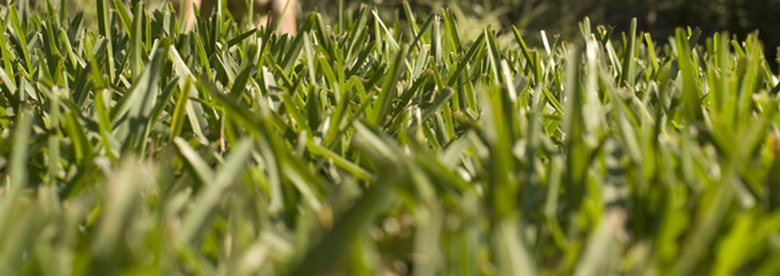How To Contain St. Augustine Grass
St. Augustine grass, known botanically as Stenotaphrum secundatum, is a warm season perennial grass that propagates itself vegetatively by creeping stolons. It thrives in moist soil and mild temperatures and will produce a lush deep green turf when watered and fertilized generously. Its stolons are best contained by cutting with trenches or physical edging barriers to slow its spread an increase intervals between edge trimming sessions. Herbicides are also an option, if you do not mind the introduction of chemicals into the landscape.
Step 1
Cut along the perimeter of your St. Augustine lawn with a manual or motorized edge trimmer or edger lawnmower, once a month or so, to sever any stolons that are creeping into adjacent areas.
Step 2
Dig an empty channel an inch or two wide and six inches deep between the edge of the lawn surface and the adjacent soil, planting bed or hardscape. Create the trench with a spade or small shovel being careful to create a straight or smoothly curving line. Repeat the process twice a year or more to keep the trench clear and the St. Augustine grass contained.
- St. Augustine grass, known botanically as Stenotaphrum secundatum, is a warm season perennial grass that propagates itself vegetatively by creeping stolons.
- Its stolons are best contained by cutting with trenches or physical edging barriers to slow its spread an increase intervals between edge trimming sessions.
Step 3
Install an edger product as a physical barrier to the grass escaping the defined area. Bender board, interlocking stone pavers or plastic edging can all be installed in a trench that is deeper than the St. Augustine grass roots, typically 6 to 8-inches beneath the soil surface. The top of the edging material should rise an inch or more above the surface of the lawn grass to prevent the grass from easily scrambling over the top of it.
Alternatives To St. Augustine Grass
Bermuda grass (Cynodon dactylon) is a highly drought-tolerant grass species widely used as turfgrass or livestock food. This warm-season grass is potentially invasive, but hybrid varieties such as "Tifgreen," "Tifdwarf," "Tifway" and "Santa Ana" do not produce seed, making them a less invasive choice than common Bermuda grass. The plant produces a flowering stem with seven spikes at the tip. Although buffalo grass survives for long periods of time without water, its leaves turn brown during periods of drought and return to green with irrigation. Zoysia grass (Zoysia spp.) is a genus of warm-season grasses that forms a thick carpet of grass very similar to St. Augustine grass. The rocks create a hot, arid environment ideal for plants with low-watering needs. Patios in the backyard eliminate the need for turfgrasses and provide outdoor entertainment space.
- Install an edger product as a physical barrier to the grass escaping the defined area.
- Bermuda grass (Cynodon dactylon) is a highly drought-tolerant grass species widely used as turfgrass or livestock food.
Things Needed
- Edge trimmer or edger mower
- Spade or small shovel
- Channel edger
- Edging material
- Herbicide sprays
References
- Texas A&M University: St. Augustine Grass
- Utah State University: Edging
- Texas A&M University AgriLife Extension: St. Augustine Grass
- University of California Division of Agriculture and Natural Resources: Managing Turfgrasses During Drought
- University of California-Davis Integrated Pest Management: Bermudagrass
- University of California-Davis Integrated Pest Management: Buffalograss — Buchloe Dactyloides
- University of California-Davis Integrated Pest Management: Zoysiagrass — Zoysia Spp.
- Sunset: Lose the Lawn: 21 Inspiring Yards
- Sunset: Grass Types
